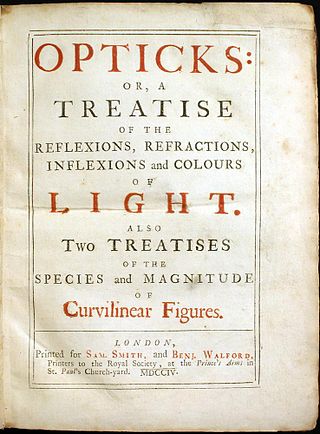This article may need to be rewritten to comply with Wikipedia's quality standards.(May 2023) |
In economics, wage dispersion is the variation in wages encountered in an economy.
This article may need to be rewritten to comply with Wikipedia's quality standards.(May 2023) |
In economics, wage dispersion is the variation in wages encountered in an economy.
Dispersion may refer to:

In optics and in wave propagation in general, dispersion is the phenomenon in which the phase velocity of a wave depends on its frequency; sometimes the term chromatic dispersion is used for specificity to optics in particular. A medium having this common property may be termed a dispersive medium.

In chemistry, a suspension is a heterogeneous mixture of a fluid that contains solid particles sufficiently large for sedimentation. The particles may be visible to the naked eye, usually must be larger than one micrometer, and will eventually settle, although the mixture is only classified as a suspension when and while the particles have not settled out.

London dispersion forces are a type of intermolecular force acting between atoms and molecules that are normally electrically symmetric; that is, the electrons are symmetrically distributed with respect to the nucleus. They are part of the van der Waals forces. The LDF is named after the German physicist Fritz London. They are the weakest intermolecular force.

Opticks: or, A Treatise of the Reflexions, Refractions, Inflexions and Colours of Light is a book by English natural philosopher Isaac Newton that was published in English in 1704. The book analyzes the fundamental nature of light by means of the refraction of light with prisms and lenses, the diffraction of light by closely spaced sheets of glass, and the behaviour of color mixtures with spectral lights or pigment powders. Opticks was Newton's second major book on physical science and it is considered one of the three major works on optics during the Scientific Revolution. Newton's name did not appear on the title page of the first edition of Opticks.

In the physical sciences and electrical engineering, dispersion relations describe the effect of dispersion on the properties of waves in a medium. A dispersion relation relates the wavelength or wavenumber of a wave to its frequency. Given the dispersion relation, one can calculate the phase velocity and group velocity of waves in the medium, as a function of frequency. In addition to the geometry-dependent and material-dependent dispersion relations, the overarching Kramers–Kronig relations describe the frequency dependence of wave propagation and attenuation.
In economics, price dispersion is variation in prices across sellers of the same item, holding fixed the item's characteristics. Price dispersion can be viewed as a measure of trading frictions. It is often attributed to consumer search costs or unmeasured attributes of the retailing outlets involved. There is a difference between price dispersion and price discrimination. The latter concept involves a single provider charging different prices to different customers for an identical good. Price dispersion, on the other hand, is best thought of as the outcome of many firms potentially charging different prices, where customers of one firm find it difficult to patronize other firms due to the existence of search costs.

In labor economics, the reservation wage is the lowest wage rate at which a worker would be willing to accept a particular type of job. This wage is a theoretical representation of the hourly rate at which an individual values their own leisure time. A job offer involving the same type of work and the same working conditions, but at a lower wage rate, would be rejected by the worker. In this case, based on the reservation wage theory, the individual would be better off not working as they value their leisure at a higher rate than the wage they would receive for working.

Dale Thomas Mortensen was an American economist, a professor at Northwestern University, and a winner of the Nobel Memorial Prize in Economic Sciences.
In fluid dynamics, dispersion of water waves generally refers to frequency dispersion, which means that waves of different wavelengths travel at different phase speeds. Water waves, in this context, are waves propagating on the water surface, with gravity and surface tension as the restoring forces. As a result, water with a free surface is generally considered to be a dispersive medium.

Chirped pulse amplification (CPA) is a technique for amplifying an ultrashort laser pulse up to the petawatt level, with the laser pulse being stretched out temporally and spectrally, then amplified, and then compressed again. The stretching and compression uses devices that ensure that the different color components of the pulse travel different distances.

Piece work or piecework is any type of employment in which a worker is paid a fixed piece rate for each unit produced or action performed, regardless of time.

Atmospheric dispersion modeling is the mathematical simulation of how air pollutants disperse in the ambient atmosphere. It is performed with computer programs that include algorithms to solve the mathematical equations that govern the pollutant dispersion. The dispersion models are used to estimate the downwind ambient concentration of air pollutants or toxins emitted from sources such as industrial plants, vehicular traffic or accidental chemical releases. They can also be used to predict future concentrations under specific scenarios. Therefore, they are the dominant type of model used in air quality policy making. They are most useful for pollutants that are dispersed over large distances and that may react in the atmosphere. For pollutants that have a very high spatio-temporal variability and for epidemiological studies statistical land-use regression models are also used.

The Royal Dutch Meteorological Institute is the Dutch national weather forecasting service, which has its headquarters in De Bilt, in the province of Utrecht, central Netherlands.
In probability theory and statistics, the index of dispersion, dispersion index,coefficient of dispersion,relative variance, or variance-to-mean ratio (VMR), like the coefficient of variation, is a normalized measure of the dispersion of a probability distribution: it is a measure used to quantify whether a set of observed occurrences are clustered or dispersed compared to a standard statistical model.
A maximum wage, also often called a wage ceiling, is a legal limit on how much income an individual can earn. It is a prescribed limitation which can be used to effect change in an economic structure, but its effects are unrelated to those of minimum wage laws used currently by some states to enforce minimum earnings.

In statistics, dispersion is the extent to which a distribution is stretched or squeezed. Common examples of measures of statistical dispersion are the variance, standard deviation, and interquartile range. For instance, when the variance of data in a set is large, the data is widely scattered. On the other hand, when the variance is small, the data in the set is clustered.

In economics, the wage ratio refers to the ratio of the top salaries in a group to the bottom salaries. It is a measure of wage dispersion.
A fan chart is made of a group of dispersion fan diagrams, which may be positioned according to two categorising dimensions. A dispersion fan diagram is a circular diagram which reports the same information about a dispersion as a box plot: namely median, quartiles, and two extreme values.